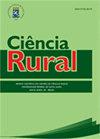Heavy metals in the soil and castor bean plants fertilized with sewage sludge stabilized by different processes
IF 0.9
4区 农林科学
Q3 AGRONOMY
引用次数: 0
Abstract
ABSTRACT: This study evaluated the levels of heavy metals in the soil and castor bean plant after fertilization with sewage sludge (SS) subjected to different stabilization processes. The study was conducted in a Haplic Cambisol with the following treatments: control (CO), fertilization with solarized sewage sludge (SSS), composted sewage sludge (CSS), vermi composted sewage sludge (VSS), limed sewage sludge (LSS), and mineral fertilizer (MF). The experimental design included a subdivided plot scheme with fertilization being the primary factor and soil layers or leaf parts being the secondary factor. The data obtained were analyzed using analysis of variance and the Scott-Knott test with 5% significance. Fertilization with SSS, CSS, and LSS led to the highest increase in Zn in the soil, mainly in the surface layer. In the leaf tissues, Zn and Cu levels were higher with the CO and SSS treatments, whereas the Ni level was higher with SSS, CSS, VSS, and MF treatments. In general, Zn and Cu levels were higher in the leaf limb than in the petiole, whereas Ni, Pb, and Cr levels were higher in the petiole than in the leaf limb. In any case, no symptoms of toxicity in the plants and no risk of soil contamination were observed with any of the fertilization treatments.污水污泥施肥对土壤和蓖麻植物重金属含量的影响
摘要/ ABSTRACT摘要:本研究对不同稳定化处理的污水污泥施肥后土壤和蓖麻植株重金属含量进行了评价。在Haplic Cambisol中进行了以下处理:对照(CO),施用污泥(SSS),堆肥污泥(CSS),蠕虫堆肥污泥(VSS),石灰污泥(LSS)和矿物肥(MF)。试验设计采用以施肥为主,土层或叶片部分为辅的细分小区方案。所得资料采用方差分析和5%显著性的Scott-Knott检验进行分析。施用SSS、CSS和LSS的土壤中锌的增加幅度最大,且主要在表层。在叶片组织中,CO和SSS处理的Zn和Cu含量较高,而SSS、CSS、VSS和MF处理的Ni含量较高。总体而言,叶柄中Zn和Cu含量高于叶柄,叶柄中Ni、Pb和Cr含量高于叶柄。在任何情况下,没有观察到任何施肥处理对植物产生毒性症状,也没有发现土壤污染的风险。
本文章由计算机程序翻译,如有差异,请以英文原文为准。
求助全文
约1分钟内获得全文
求助全文
来源期刊

Ciencia Rural
AGRONOMY-
CiteScore
1.70
自引率
0.00%
发文量
233
审稿时长
2-4 weeks
期刊介绍:
The purpose of Ciência Rural is to publish the results of original research, note and reviews which contribute significantly to knowledge in Agricultural Sciences. Preference will be given to original articles that develop news concepts or experimental approaches and are not merely repositories of scientific data. The decison of acceptance for publication lies with the Editors and is based on the recommendations of Editorial Comission, Area Committee and/ or ad hoc reviewers. The editors and reviewers are external to the institution.
 求助内容:
求助内容: 应助结果提醒方式:
应助结果提醒方式:


